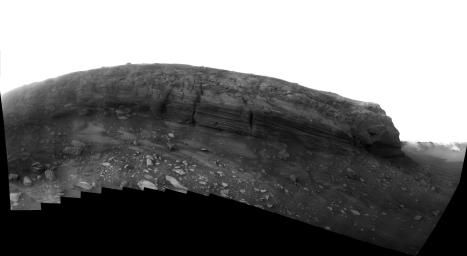
|
Dusk Lighting of Layered Textures in ‘Cape Verde’
- Click the image above for a larger view
- Full-Res JPEG (9497 x 5200) (3.1 MB)
- Full-Res TIFF (9497 x 5200) (49.4 MB)
Caption:
Full-shade lighting in the late Martian afternoon helps make details visible in this view of the layered cliff face of the "Cape Verde" promontory making up part of the rim of Victoria Crater in the Meridiani Planum region of equatorial Mars.
NASA's Mars Exploration Rover Opportunity used its panoramic camera (Pancam) to shoot the dozens of individual images that have been combined into this mosaic. Opportunity was inside Victoria Crater and near the base of the cliff when it took these images on the 1,579th and 1,580th Martian days, or sols, of the mission (July 2 and 3, 2008).
Photographing the promontory from this position in Victoria Crater presented challenges for the rover team. The geometry was such that Cape Verde was between the rover and the sun, which could cause a range of negative effects, from glinting off Pancam's dusty lenses to shadowing on the cliff face. The team's solution was to take the images for this mosaic just after the sun disappeared behind the crater rim, at about 5:30 p.m. local solar time. The atmosphere was still lit, but no direct sunlight was illuminating the wall of Cape Verde.
The result is a high-resolution view of Cape Verde in relatively uniform diffuse sky lighting across the scene.
Pancam used a clear filter for taking the images for this mosaic. Capturing images in low-light situations was one of the main motivations for including the clear filter among the camera's assortment of filters available for use.
The face of Cape Verde is about 6 meters (20 feet) tall. Victoria Crater, at about 800 meters (one-half mile) wide, is the largest and deepest crater that Opportunity has visited. It sits more than 5 kilometers (almost 4 miles) away from Opportunity's Eagle Crater landing site. Researchers sent Opportunity into Victoria Crater to study the rock layers exposed inside. The textures seen in the rock layers of Cape Verde suggest that the exposed layers were originally deposited by wind.
Cataloging Keywords:
| Name | Value | Additional Values |
|---|---|---|
| Target | Mars | |
| System | ||
| Target Type | Planet | |
| Mission | Mars Exploration Rover (MER) | |
| Instrument Host | Opportunity (MER-B) | |
| Host Type | Rover | |
| Instrument | Panoramic Camera (Pancam) | |
| Detector | ||
| Extra Keywords | Atmosphere, Crater, Dust, Grayscale, Shadow | |
| Acquisition Date | ||
| Release Date | 2008-08-26 | |
| Date in Caption | ||
| Image Credit | NASA/JPL/Cornell | |
| Source | photojournal.jpl.nasa.gov/catalog/PIA11048 | |
| Identifier | PIA11048 | |
